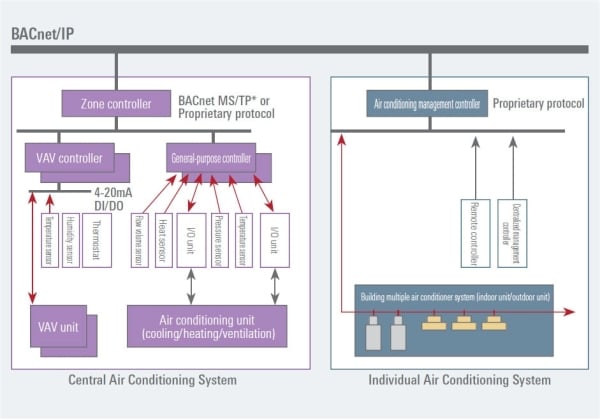HVAC Motor Control
The following tables list the units requiring motor control that are used in the two types of air conditioning systems. The use of inverters and brushless DC motors is increasing in variable-speed motor control applications requiring energy efficiency. In addition, an individual indoor unit or outdoor unit may contain multiple motors requiring control. Renesas offers development kits for the control systems most appropriate for three motor types: induction motors, brushless DC motors, and stepping motors. Also, we offer a wide range of products that are able to control multiple motors, from low-end to high-end, low power consumption, and microcontrollers equipped with floating-point processors (FPUs).
Motor Control Units in Central Air Conditioning Systems
| Unit | Motor Control Application |
|---|---|
| AHU | Fan |
| FCU | Fan |
| VAV | Damper |
| Outdoor-air processing unit | Fan |
| Chiller | Compressor |
| Heat source | Fan |
| Cooling tower | Fan |
| Feed water pump | Pump |
| Cooling water pumps | Pump |
Motor Control Units in Individual Air Conditioning Systems
| Unit | Motor Control Application |
|---|---|
| Indoor unit | Fan, damper |
| Outdoor unit | Fan, compressor |
| Outdoor-air processing unit | Fan |

HVAC Communications
Regardless of the type of air conditioning system, generally speaking, the various units are connected to a wired or wireless network to facilitate control and state management. In the context of building automation in particular, BACnet* is used to connect HVAC devices from different manufacturers and configure the building management system. The figure below shows conceptual diagrams of HVAC system communication in a central air conditioning system and an individual air conditioning system, respectively. In the central air conditioning system, digital signals (DI and DO) and analog signals (4-20mA) are used for communication between sensors, VAV units, and general-purpose controllers. Due to the long distances involved and the need for noise tolerance, Renesas offers communication solutions that employ power line communication (PLC).
*BACnet (Building Automation and Control Networking Protocol) is an open protocol established in 1995 by the American Society of Heating, Refrigerating and Air-Conditioning Engineers (ASHRAE). In 2003 it was adopted as the international standard ISO 16484-5.
HVAC User Interface
They employ devices that use human-machine interface (HMI) technology such as fan coil units (FCUs), variable air volume (VAV), and remote control for indoor machines to operate a screen in order to adjust the set temperature individually. The recent trend is away from using fixed mechanical keys (mechanical switches) and toward the use of touch panels. These touch panels must be able to withstand demanding environmental conditions, including high noise levels, water, dirt, and temperature variations. Renesas offers HMI solutions that meet these challenges.
Sensor Products for HVAC
A sensor lineup, a technology required for building automation, has been added. Sensors for various cases can be introduced, supporting the improvement of air quality and the creation of comfortable building spaces.
- Temperature and Humidity Sensors
- Flow Volume and Airflow Sensors
- Air Quality (Gas) Sensors
- Light Sensors

